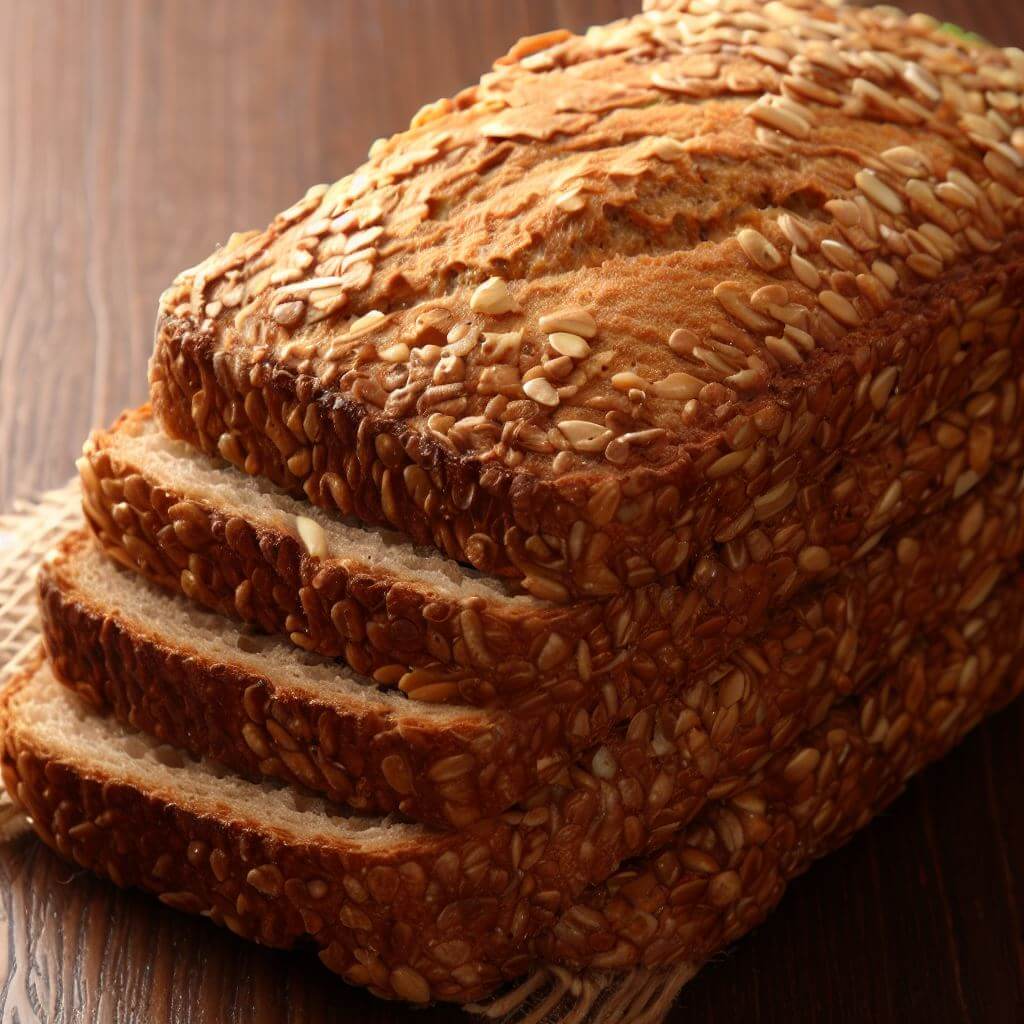Why Bread Substitutes Matter
Managing one’s blood sugar levels is far from a trivial matter; it’s an essential, ongoing practice for the millions of people who live with diabetes. Diet plays an indispensable role in this management strategy. Bread, a common component of breakfast, lunch, and dinner for many, often presents a challenge due to its high carbohydrate content. These carbs can cause spikes in blood sugar levels, making it crucial for diabetics to find acceptable alternatives. But what characteristics define a “good” bread alternatives for diabetics? In this article, we’ll delve into various aspects to consider, followed by a comprehensive list of ten top bread alternatives that could fit into a diabetic-friendly diet.
The Essential Checklist: What to Seek in a Bread Alternative
When you’re on the hunt for a bread alternative that won’t sabotage your blood sugar levels, several factors come into play. These aren’t merely food choices; they’re choices that impact your health. So, what should be on your checklist?
Carbohydrate Content
The lower the carbohydrate content, the less impact a food item will have on your blood sugar. Some bread alternatives are exceptionally low in carbs, making them excellent options. It’s not just about avoiding spikes in blood sugar; it’s also about maintaining steady levels throughout the day.
Fiber Content
Remember the saying, “Fiber is your friend”? Well, it holds, especially for diabetics. Fiber slows down the absorption of sugar, which in turn slows down its impact on blood sugar levels. Foods high in fiber are not only beneficial for blood sugar management but also for digestive health.
Glycemic Index
The Glycemic Index (GI) measures how quickly a particular food item raises blood sugar levels. Lower GI foods are processed more slowly by the body, causing a more gradual rise in blood sugar. When considering bread alternatives, those with a lower GI are generally better options.
By focusing on these aspects—carbohydrate content, fiber, and glycemic index—you arm yourself with the information necessary to make better dietary choices. Armed with this knowledge, you can explore the various bread alternatives we have compiled for you, each with its unique set of pros and cons tailored to a diabetic-friendly diet.
10. Whole Wheat Tortillas: Not Just Another Bread

Kicking off our list at number 10 are Whole Wheat Tortillas. At first glance, you might dismiss tortillas as merely another form of bread. However, such a swift judgment would be doing them a disservice.
Whole Wheat Tortillas differ significantly from traditional white bread, which undergoes a refining process that eliminates many nutrients. In contrast, whole wheat tortillas keep the entire grain intact. This includes the bran, germ, and endosperm—all essential components contributing to its nutrient-rich profile.
Why Choose Whole Wheat Tortillas?
Fiber-Rich Benefits
The fiber content in whole wheat tortillas is notably higher than their white counterparts, averaging about 4 to 5 grams of fiber per serving. This compares favorably with the mere 1 gram found in white tortillas. The significance of this is crucial, especially for diabetics. According to a 2019 meta-analysis published in the journal Nutrients, increased fiber intake leads to improved glycemic control in people with diabetes. Why is this so? Fiber slows down the rate at which sugar is absorbed into the bloodstream, ensuring a more consistent energy level without the dreaded spike and subsequent crash.
Nutrient Density
Whole Wheat Tortillas also serve as a repository for essential nutrients such as magnesium, which aids in regulating blood sugar, and B-vitamins, key players in energy metabolism. Some brands go the extra mile by fortifying their tortillas with folic acid, vital for cellular repair and maintenance. The result? Each time you opt for a whole wheat tortilla, you’re not merely satisfying your palate, but you’re also nourishing your body.
9. Ezekiel Bread: The Sprouted Superstar
Sitting at number 9 on our list is Ezekiel Bread, a bread variety that has been steadily rising in both consumer awareness and popularity. What sets this bread apart? It’s the unique combination of sprouted grains and legumes that make Ezekiel Bread stand out as a nutritional powerhouse.

Why Sprouted Grains?
Sprouting is not just a buzzword; it has significant nutritional implications. When grains are sprouted, they undergo a form of “pre-digestion,” which makes nutrients like iron, vitamin C, and folate more bioavailable. This means that your body can absorb these nutrients much more effectively compared to their non-sprouted counterparts.
A Complete Protein Source
Another compelling reason to consider Ezekiel Bread is its status as a complete protein source. Unlike many other types of bread, Ezekiel Bread contains all nine essential amino acids. This feature has important implications for managing weight, a concern for many diabetics. Protein helps you feel full for a more extended period, reducing the urge to snack on unhealthy foods that could potentially spike your blood sugar levels.
Glycemic Index: The Lower, The Better
The Glycemic Index (GI) is a critical factor to consider when choosing foods that are safe for diabetics. The GI for Ezekiel Bread is approximately 36, which is significantly lower than many commercial breads. A study published in the Journal of Nutrition and Metabolism confirmed that sprouted grains led to a minimal increase in blood sugar. This makes Ezekiel Bread not just a delicious choice for sandwiches or toasts but also a smart one for those looking to manage their diabetes effectively.
8. Almond Bread: A Nutty Revolution in Bread Alternatives

Climbing up to number 8 on our list, Almond Bread takes the limelight as a superb substitute for traditional wheat-based breads. Its unique, nutty flavor brings a new dimension to your meals, but there’s much more to it than just taste.
Almond Bread comes with an impressive nutritional profile that offers multiple health benefits, particularly for people managing diabetes.
Why Almond Bread is a Winning Choice
Low Carb, High Satisfaction
Almonds are naturally low in carbohydrates but rich in healthy fats and proteins. This combination makes Almond Bread a fabulous candidate for glycemic control. A 2011 study published in Metabolism: Clinical and Experimental revealed that almond consumption contributed to better glycemic control and lipid profiles in individuals with type 2 diabetes.
A Wealth of Nutrients
But the goodness doesn’t stop there. Almond Bread is loaded with vitamin E, a potent antioxidant known to fight inflammation and support heart health. Additionally, it’s an excellent source of magnesium, a crucial mineral that serves multiple purposes—from regulating blood sugar to supporting muscle function and bone health. Every bite you take isn’t just a delight to your taste buds; it’s also a multi-dimensional boost to your well-being.
7. Cauliflower Crust: Where Veggies and Bread Unite
At number 7, we have a true game-changer in the bread alternative scene—Cauliflower Crust. If you’re skeptical about a vegetable standing in for bread, prepare to have your expectations exceeded. Not only does cauliflower crust taste great, but it also offers a smorgasbord of health benefits that traditional bread simply can’t match.

Cauliflower Crust Unveiled
Carb Counters, Rejoice!
While a regular slice of white bread could saddle you with around 14 grams of carbs, a serving of cauliflower crust generously scales that down to just 3 grams. A study in the journal Nutrients in 2017 found that cauliflower consumption offers a range of health benefits, from anti-inflammatory properties to reducing the risk of certain cancers.
Nutrient-Dense and Versatile
But that’s not all. Cauliflower is also a rich source of choline, a nutrient essential for a multitude of bodily functions, such as brain development and metabolism. Moreover, it provides a good dose of vitamin C and potassium, which are indispensable for immune function and heart health. With Cauliflower Crust, you’re not just substituting bread; you’re upgrading your entire meal in terms of nutritional value.
6. Portobello Mushroom Buns: Turning Meals into Masterpieces

Landing at number 6 on our esteemed list are Portobello Mushroom Buns. If you ever wished to elevate your burgers and sandwiches to the realms of culinary art while maintaining a health-conscious approach, then these buns are your golden ticket.
Why Choose Portobello Mushroom Buns?
Nutrient-Packed and Fiber-Filled
Portobello mushrooms are far from being nutritional lightweights. They come packed with essential nutrients like selenium, potassium, and copper. But let’s not overlook the fiber content, which, much like our other contenders, helps in slowing down sugar absorption—making them an optimal choice for diabetes management.
Antidiabetic Properties
A 2019 study published in the Journal of Functional Foods discovered that mushrooms, thanks to their rich polysaccharide content, have antidiabetic properties. Additionally, their low calorie and high water content make them a superb choice for those focusing on weight management, an integral aspect of controlling blood sugar levels.
When the grill is hot, and you’re prepping for a sumptuous meal, consider swapping out the bread for some Portobello mushroom caps. You’ll dramatically cut back on carbohydrates, while diving into an unforgettable and healthful dining experience.
5. Bell Pepper Sandwiches: The Crispy, Nutrient-Packed Stand-in for Bread

Nestled at number 5 on our countdown are Bell Pepper Sandwiches, proving that bell peppers aren’t just a side-kick in your salads or stir-fries—they can be the star of the show.
The Nutritional Goldmine of Bell Pepper Sandwiches
Antioxidant-Rich Powerhouse
Bell peppers are an exceptional source of vitamins A, C, and E, making them antioxidant-rich warriors that fight against inflammation and help bolster your immune system. Their vibrant colors aren’t just for show; they signify a plethora of health benefits that traditional bread simply can’t offer.
A Winning Pick for Diabetes Management
According to the American Diabetes Association, foods that are high in fiber yet low in calories, like bell peppers, can significantly help in controlling blood sugar levels. Astonishingly, bell peppers boast a Glycemic Index of a mere 15, categorizing them as one of the lowest glycemic foods one can consume.
The Capsaicin Bonus
Don’t underestimate the spiciness; bell peppers contain capsaicin, a compound renowned for its anti-inflammatory and pain-relieving properties. When you opt for a Bell Pepper Sandwich, you’re not merely satisfying your hunger. You’re nourishing your body with an assortment of nutrients that contribute to overall well-being.
4. Nori Wraps: The Ocean’s Gift to Low-Carb Diets
At number 4, we have Nori Wraps, a testament to the culinary versatility of seaweed. While most commonly associated with sushi, Nori’s applications can extend way beyond that, making it a fantastic bread alternative.

Dive Into the Nutritional Depths of Nori Wraps
Low-Carb, High Reward
Nori sheets are practically carb-free, making them an ideal alternative for individuals concerned about their blood sugar levels. But don’t let the low-carb label fool you into thinking it’s nutritionally empty; it’s quite the opposite.
A Thyroid’s Best Friend
A study in the Journal of Applied Phycology highlighted the high iodine content in seaweeds like Nori. Iodine is an essential nutrient that plays a pivotal role in maintaining proper thyroid function, and by extension, a healthy metabolism.
Heart and Health
Nori is also a good source of omega-3 fatty acids, crucial for improving heart health. Additionally, it contains bioactive peptides with antidiabetic properties, according to research in Marine Drugs. Choosing Nori wraps is much more than a culinary decision; it’s a declaration of commitment to a healthier lifestyle.
3. Cucumber Subs: Crunch Your Way to Health

Making waves at the third position are Cucumber Subs. This refreshing alternative lets you enjoy all the flavors of a traditional sub sandwich but without the hefty carbohydrate content.
The Low-Carb Marvel That is Cucumber Subs
A Dramatic Carb Cut
While a conventional sub roll can overwhelm you with as much as 40 grams of carbohydrates, cucumber ‘buns’ offer a staggering cut down to approximately 3.6 grams per 100 grams. This makes Cucumber Subs an almost guilt-free indulgence.
Nutrients Galore
According to a study in Phytotherapy Research, cucumbers are rich in antioxidants like beta-carotene and tannins, known for their anti-inflammatory properties. They also provide excellent hydration, boasting about 95% water content.
An Ally Against Diabetes
Research published in the Journal of Plant Foods for Human Nutrition found that cucumber extracts can lower blood sugar levels and even prevent diabetes-related complications.
So, the next time you’re pondering over which bread alternative to go for, consider Cucumber Subs. They offer a satisfying crunch and a cornucopia of nutrients, proving that making healthier choices doesn’t mean compromising on flavor or satisfaction.
2. Eggplant Roll-Ups: The Purple Powerhouse of Nutritional Versatility
Stepping up to the second spot are Eggplant Roll-Ups. Often relegated to classic dishes like Eggplant Parmesan, this glossy purple vegetable is now ready to take on a new role as a creative replacement for bread.

Imagine thinly sliced eggplant, roasted or grilled to perfection, acting as a robust, nutrient-dense ‘wrapper’ for a variety of fillings—be it meat, cheese, or an assortment of vegetables.
Unlocking the Nutritional Goodness of Eggplant
Phenolic Compounds and Diabetes Management
What truly distinguishes eggplants are their nutritional attributes. A study published in Food Chemistry reveals that eggplants are rich in phenolic compounds, compounds known for their anti-diabetic properties. The vegetable also presents a low-carb profile, with a mere 9 grams of carbs per cup of raw eggplant, making it suitable for those watching their carbohydrate intake.
The Fiber Factor
Furthermore, the fiber content in eggplants contributes to blood sugar regulation by slowing down the digestion of carbohydrates. This makes eggplant roll-ups not just a delicious but also a strategically healthy choice for people with concerns about glycemic control.
Antioxidant Marvel: Nasunin
An additional feather in its cap is nasunin, an antioxidant highlighted in research published in the Journal of Agricultural and Food Chemistry for its neuroprotective effects. This purple-skinned beauty does more than just satisfy your taste buds; it provides multiple layers of health benefits that extend from regulating blood sugar to protecting your brain cells.
1. Lettuce Wraps: The Ultimate Low-Carb, Health-Boosting Option

At the top of our list, deserving of the crown, are Lettuce Wraps. These leafy greens offer a combination of simplicity, versatility, and a nutritional profile that’s hard to beat. Whether you’re filling them with lean meats, cheeses, an array of veggies, or delicious spreads, lettuce wraps have got you covered, all while keeping your carb count at rock bottom.
Nutritional Highlights of Lettuce Wraps
The Almost Zero-Carb Marvel
An individual large leaf of lettuce contains approximately 2 grams of carbohydrates, practically making it a ‘free food’ in the low-carb and diabetic-friendly dietary world. For those counting every gram, this feature alone makes lettuce wraps an unbeatable option.
The Nutrient-Dense Champion
Don’t let the water content fool you; lettuce leaves are rich in nutrients. They offer a variety of essential vitamins, such as A, K, and C, enhancing everything from eye health to blood clotting and immune function.
Leafy Greens for Diabetes Prevention
Most impressively, lettuce wraps aren’t just a reactive dietary choice for those with health concerns; they are a proactive measure for long-term wellness. According to a 2018 study in the Journal of Nutrition, higher consumption of leafy greens is linked with a decreased risk of developing type 2 diabetes.
Additional Tips for Diabetics: Beyond Food Swaps
Monitoring Blood Sugar
Even with low-carb and nutrient-dense food choices, it’s essential to regularly monitor your blood sugar levels. This practice helps you understand how different foods and meals affect you, enabling you to make more informed decisions.
Exercise Regularly
A balanced diet pairs best with regular physical activity. Exercise helps in regulating blood sugar levels and improving insulin sensitivity. Even a 30-minute walk each day can make a significant difference.
Portion Control
Remember, it’s not just what you eat but also how much you eat that matters. Proper portion control can help prevent spikes in blood sugar levels, even if the food is considered diabetes-friendly.
Stay Hydrated
Adequate hydration is vital for everyone but particularly so for diabetics. Proper hydration can help regulate blood sugar levels. Stick to water or drinks without added sugar.
Consult a Professional
Although dietary changes can significantly impact diabetes management, it’s crucial to consult with healthcare providers for a tailored treatment plan. This may include medication or insulin therapy, alongside dietary and lifestyle changes.
Navigating the Low-Carb Jungle
We’ve delved into 10 outstanding bread alternatives suitable for diabetics. To help you remember and visualize these options, we’ve summarized them all in the video below. This recap will be your go-to guide when you’re grocery shopping or planning meals. Watch it now for a quick and handy reference!
In this exploration of Bread Alternatives For Diabetics, we’ve looked at options that not only satisfy your taste buds but also provide a myriad of health benefits. From the nutty goodness of Almond Bread to the refreshing crunch of Lettuce Wraps, there’s something for everyone. These aren’t just food swaps; they’re lifestyle upgrades that offer more than you could expect—improved glycemic control, inflammation reduction, and a boost in essential nutrients. So go ahead, take that first step toward a healthier, tastier life.
Frequently Asked Questions (FAQs)
Q: Can I completely replace traditional bread with these Bread Alternatives For Diabetics?
A: While these alternatives are excellent for reducing carb intake and managing blood sugar, they shouldn’t entirely replace all components of a balanced diet. Always consult a healthcare provider for personalized dietary advice.
Q: How can I make these Bread Alternatives For Diabetics taste better?
A: Spices, herbs, and healthy sauces can add flavor without significantly affecting your carb count. For example, garlic powder, paprika, and fresh basil can enhance the flavor profile of your eggplant roll-ups or cauliflower crust.
Q: Are these alternatives suitable for non-diabetics?
A: Absolutely. These options are not only good for diabetics but also beneficial for anyone looking to reduce carbs, lose weight, or simply incorporate more vegetables into their diet.
Q: Can I prepare these alternatives in advance?
A: Most of these alternatives can be prepared in advance and stored in the fridge for a couple of days. However, lettuce wraps are best consumed fresh to maintain their crunch.
Q: Where can I buy these alternatives?
A: Many of these alternatives can be made at home with fresh ingredients. Pre-made versions of things like almond bread or cauliflower crust may also be available at health food stores or in the specialty sections of larger grocery stores.





